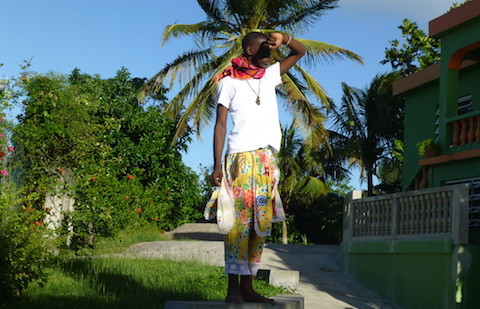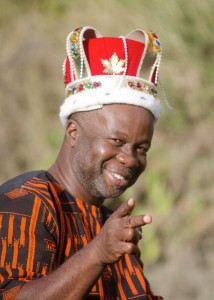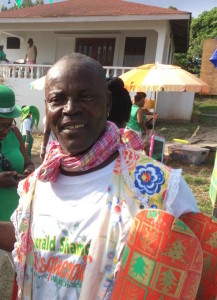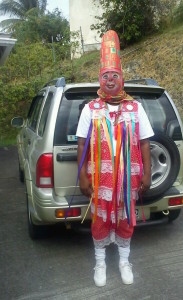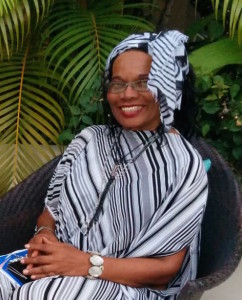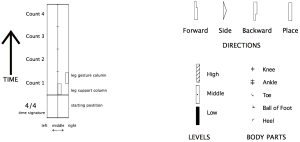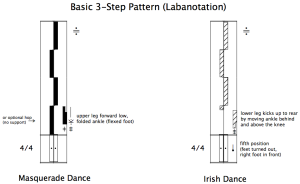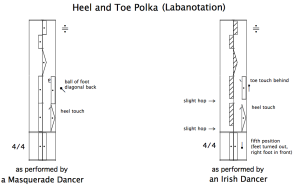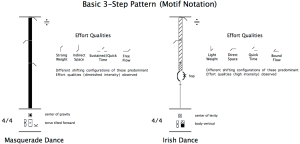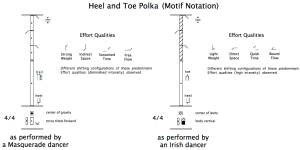The photos and figures posted here are referenced by number in Kathleen Spanos’ dissertation:
“Dancing the Archive: Rhythms of Change in Post-Volcano Identities on Montserrat, West Indies”
Click the links below to jump to chapters; click images to view full size
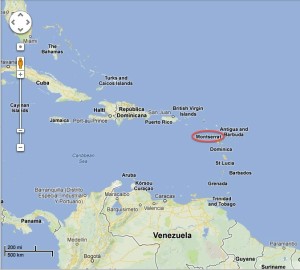
M.1 Map of Montserrat in the Caribbean. Montserrat is 39.5 square miles and has a population of about 5,000 residents. Travelers must travel to Antigua before taking the ferry or a small eight-seater plane to Montserrat. Image source: http://maps.google.com, accessed April 14, 2013.
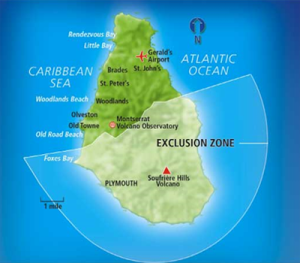
M.2 Map of Montserrat’s Exclusion Zone. Plymouth was the capital city of Montserrat before the volcano destroyed the southern two-thirds of the island between 1995-1997. This area is now called the Exclusion Zone and is often described as a modern-day Pompeii. Image source: http://www.clubtread.com/forumPix/410000/410861.jpg, accessed April 25, 2013.
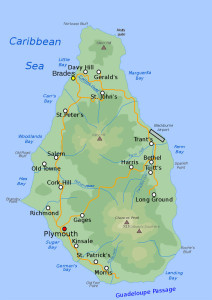
M.3 Map of villages of Montserrat. This map shows some of the larger villages on Montserrat, including those in the southern areas, such as Plymouth (the capital), Kinsale, and St. Patrick’s. All of these southern villages are now abandoned in the Exclusion Zone due to the volcanic destruction (see Map M.2). Government headquarters is currently located in Brades and a new capital city is planned for Little Bay. Image source: http://www.paradise-islands.org/montserrat/images/Montserrat-Map.jpg, accessed April 25, 2013.
Introduction:
An Orientation to Montserrat

I.1 St. Patrick’s Week and African Music Festival Banner. The 2013 St. Patrick’s Week and African Music Festival website banner depicts women from the Emerald Community Singers dressed in the Montserratian national dress (far left) and African drums (far right), interspersed with masquerade dancers, steel pans, and shamrocks. The Montserrat Tourist Board posted this banner online at www.visitmontserrat.com in March 2013.
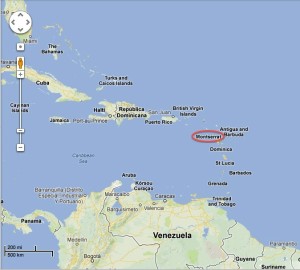
I.2 Map of Montserrat in the Caribbean. Montserrat is 39.5 square miles and has a population of about 5,000 residents. Travelers must travel to Antigua before taking the ferry or a small 8-seater plane to Montserrat. Image source: http://maps.google.com, accessed April 14, 2013.
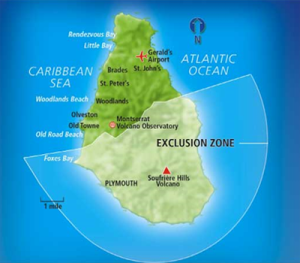
I.3 Map of Montserrat’s Exclusion Zone. Plymouth was the capital city of Montserrat before the volcano destroyed the southern two-thirds of the island between 1995-1997. This area is now called the Exclusion Zone and is often described as a modern-day Pompeii. Image source: http://www.clubtread.com/forumPix/410000/410861.jpg, accessed April 14, 2013.
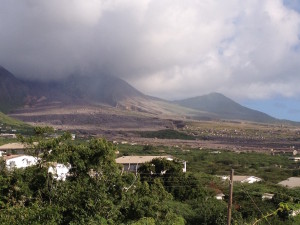
I.4 View of Plymouth. This photograph from 2014 shows a view of the volcano (left, covered by clouds) and the abandoned capital city of Plymouth (far right) from the old Montserrat Springs Hotel in Richmond Hill. Some of the land is green and overgrown now, but much of the area is still covered in gray ash. Photograph by Kathleen Spanos (January 11, 2014).
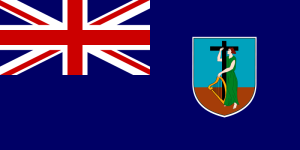
I.5 Flag of Montserrat. Montserrat’s national flag includes the flag of Great Britain in the upper left quadrant and Montserrat’s coat of arms on the right side. The coat of arms features Erin (Ireland personified) holding an Irish harp and a black cross. Image source: http://www.worldatlas.com/webimage/countrys/namerica/caribb/montserrat/mspics/flagpics/montserflag.png, accessed April 14, 2013.
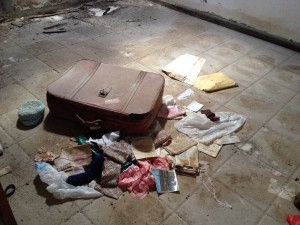
I.6 Abandoned suitcase in Richmond Hill. An abandoned suitcase with clothes, photographs, and letters left behind in a house in Richmond Hill in the restricted access/permit-only area of Zone C. (Unrestricted access to this area was granted in 2015.) Photograph by Kathleen Spanos (July 20, 2014).
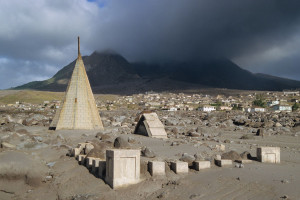
I.7 Plymouth Catholic Church buried. This image shows the spire of the Catholic Church in Plymouth and the roofs of other buildings in the capital city, just barely visible above the layer of thick lahar (mudlike) deposits that resulted from eruptions in late 1997. Image source: http://www.photovolcanica.com/Pictures_V5/v5_hp10.jpg, accessed October 12, 2015.
Chapter 1:
Searching for Montserrat’s Archive:
Irish and African Identities in the Island’s History
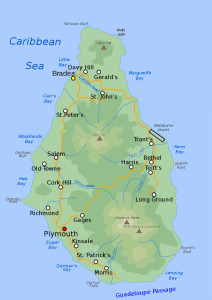
1.1 Map of villages of Montserrat. It is unclear whether Irish settlers on Montserrat first arrived at Sugar Bay in the south or Carr’s Bay in the north, but it is possible that both harbors were used—the former by settlers from St. Kitts and the latter by settlers from Virginia (Fergus 1975, 8-9; Messenger 1967). The largest populations of Irish on Montserrat in the seventeenth century up until the twentieth century were in the south and west of the island, in Plymouth (the capital), Kinsale, and St. Patrick’s. All of these towns are now abandoned due to the volcanic destruction. Image source: http://www.paradise-islands.org/montserrat/images/Montserrat-Map.jpg, accessed April 14, 2013.
Chapter 2:
Rhythms of Change in Montserrat’s Masquerade Dance
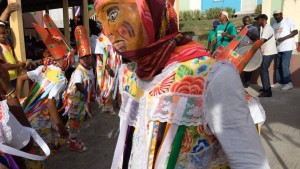
2.1 Emerald Shamioles at Calabash Festival. Dancers in the Emerald Shamioles masquerade troupe perform with their band at the Calabash Festival Grand Food Fair at the Lyme Centre in Brades. Photograph by Kathleen Spanos (July 18, 2014).
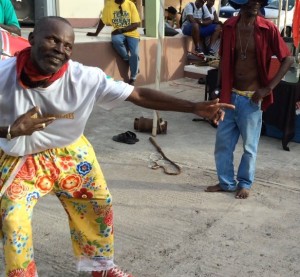
2.2 Masquerade captain Titus performs unmasked. Titus removes his captain’s mask and vest and puts down his whip to perform a solo during the Calabash Festival Grand Food Fair. Photograph by Kathleen Spanos (July 18, 2014).
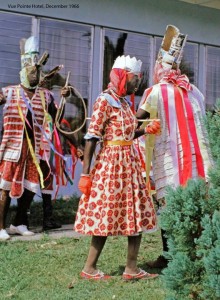
2.3 Masquerade Queen. The masquerade Queen dances with a troupe performing at the Vue Pointe Hotel in December 1966. This photograph was posted on Facebook group Vintage Montserrat, where commenters explained that the troupe was from Cork Hill and the Queen role was played by Donna Henry, then a young girl and now a librarian at the National Trust. Photograph courtesy of Sally Doria.
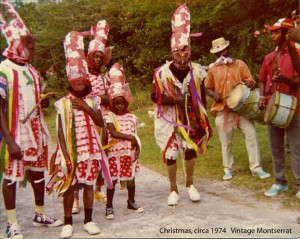
2.4 St. John’s masquerade troupe around 1974. The pre-volcano St. John’s masquerade troupe performs from door-to-door at Christmas around 1974. This photograph was posted on Facebook group Vintage Montserrat with a caption explaining that this is the famous Fergus family of the St. John’s masquerades (the family of Eric Fergus, who is mentioned in this chapter and in Chapter 3 for his calypso song that refers to his experiences as a masquerade dancer). Photograph courtesy of Sally Doria.
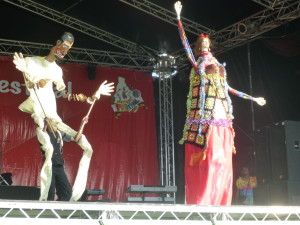
2.5 Miss Goosie and Mr. Goosie on Festival Day. Stilt characters Miss Goosie (right, with a real cigarette smoking in her mouth) and Mr. Goosie (left) dance around the stage to soca music on Festival Day during Christmas Festival. Photograph by Kathleen Spanos (December 31, 2013).
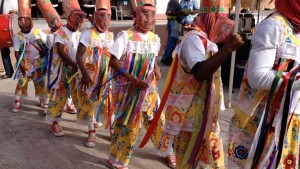
2.6 Emerald Shamioles line up at Calabash Festival. The Emerald Shamioles line up in order of height and perform in costume at the Calabash Festival Grand Food Fair. They wear yellow floral-patterned costumes with ribbons, masks, red Chuck Taylor sneakers, and Christmas paper-wrapped headdresses. Photograph by Kathleen Spanos (July 18, 2014).
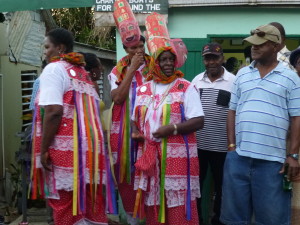
2.7 Ladies of Alliouagana on St. John’s Day. Members of the Ladies of Alliouagana masquerade troupe in costume on St. John’s Day (December 27th) in St. John’s village. Their costumes are made of a red (rather than yellow) patterned fabric with mirrors sewn on the shoulders and back, but they wear the same style of masks and headdresses as the Emerald Shamioles. Photograph by Kathleen Spanos (December 27, 2013).
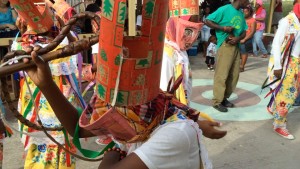
2.8 A young masquerader picks up the captain’s whip. A young masquerade performer dances briefly with the captain’s whip in between sections of the Emerald Shamioles performance at the Calabash Festival Grand Food Fair. Photograph by Kathleen Spanos (July 18, 2014).
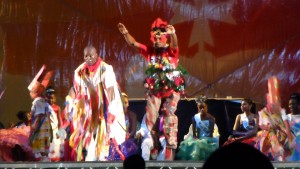
2.9 Titus and Basil dance masquerade on New Year’s Day. Emerald Shamioles captain James “Titus” Frederick (left) and Basil “Krismuss” Chambers (right) dance masquerade at the New Year’s Day festival performance at Festival City. Photograph by Kathleen Spanos (January 1, 2014).
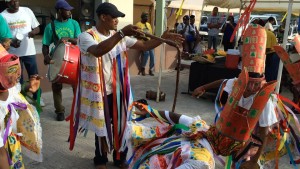
2.10 Basil dances the captain’s role at Calabash Festival. Basil Chambers dons Titus’ vest and wields his whip to temporarily take over the role of captain. Photograph by Kathleen Spanos (July 18, 2014).
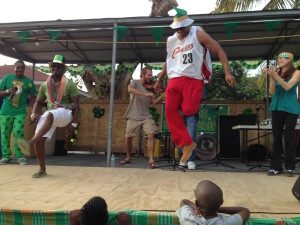
2.11 Irish dance performance on St. Patrick’s Day. Basil Chambers (left, dressed in shamrock trousers) invites local Montserratians, including masquerade dancer Kulcha Don (in red trousers), from the crowd to imitate Kate Spanos’ (right) Irish dance performance at the 2015 St. Patrick’s Festival Slave Feast. The other dancer is Gary Morton from Montserrat and the fiddler is Andreas Tholl, visiting Montserrat for the first time from Denmark. Photograph by Pablo Regis de Oliveira (March 17, 2015).
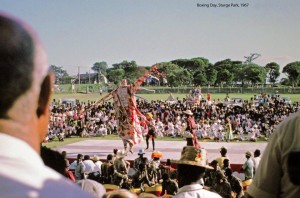
3.1 Miss Goosie on Boxing Day in 1967. Stilt character Miss Goosie performs on the Festival stage on Boxing Day (December 26th) in Sturge Park in Plymouth in 1967, before the volcano. She looked different then than she does now (see Figure 2.5)—taller, and with more of a masquerader-like costume with ribbons rather than the knitted wool shawl and cigarette-smoking doll’s head that she has today. Photograph courtesy of Sally Doria.
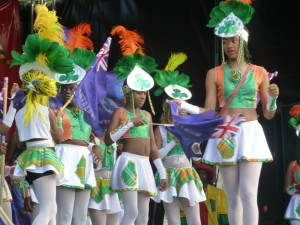
3.2 “Emerald Splendour” mas troupe on Festival Day. Members of the “Emerald Splendour” mas troupe (sponsored by Bijoux Productions) wave Montserrat flags and model their costumes on stage for Festival Day. Their outfits feature shamrocks, Montserrat island-shaped appliqués in the national madras dress pattern, and green, orange, and yellow feathered and beaded headdresses. Photograph by Kathleen Spanos (December 31, 2013).
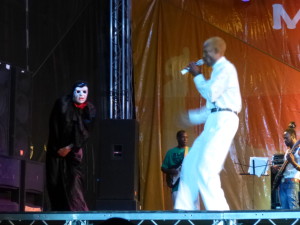
3.3 Baptiste Wallace sings “Dracula System”. “Triple King” Baptiste Wallace achieved an unprecedented sweep of all three Festival Monarch competitions in 2013, winning the Calypso, Soca, and Road March crowns with his hit song, “Dracula System” (Appendix C.4). Singing lyrics written by Cecil “Cepekee” Lake, the Dominican-born fisherman-turned-calypsonian commented on the ways that the government and other big businesses like Fly Montserrat airlines “suck your money,” and “the prices in the shop, never ever drop.” Photograph by Kathleen Spanos (December 20, 2013).
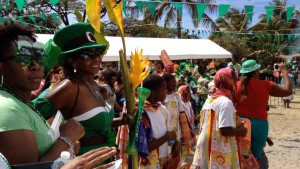
3.4 St. Patrick’s Day Slave Feast. Festivalgoers and masquerade dancers wearing masks and costumes gather in Heritage Village in Salem for St. Patrick’s Day festivities. The Slave Feast is a time to commemorate Montserrat’s slave ancestors—the event is set up to resemble a “maroon community” of communal sharing, performances feature local and visiting artists, and vendors set up stalls to sell local foods and crafts. Photograph by Kathleen Spanos (March 17, 2014).
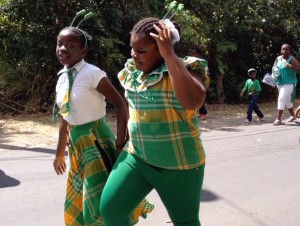
3.5 Irish dancers wearing the national dress. Girls dancing in the 2014 St. Patrick’s Day parade wear outfits featuring the national dress pattern, as well as shamrock stickers and head boppers. Photograph by Kathleen Spanos (March 17, 2014).
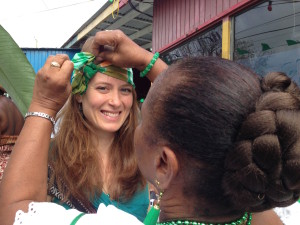
3.6 National dress “coronation”. I purchased my first national dress accessory on St. Patrick’s Day in 2015, on the two-year anniversary of my first visit to Montserrat. Photograph of Kate Spanos by Pablo Regis De Oliveira (March 17, 2015).
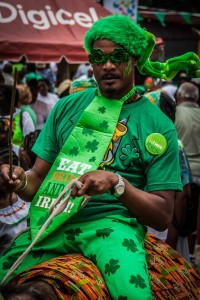
3.7 Basil Chambers in “paddywhackery” on St. Patrick’s Day. At the Slave Feast on St Patrick’s Day in 2015, Basil Chambers rides a donkey in full “paddywhackery,” including shamrock-patterned pants, shamrock sunglasses, and an oversized tie that reads: “Eat, Drink, and Be Irish!” Photograph courtesy of the Montserrat Governor’s Office.
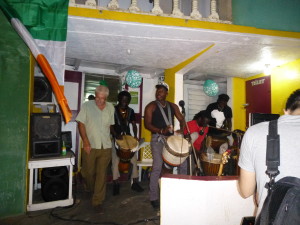
3.8 Jalikunda performs during St. Patrick’s Week. Jalikunda West African Drumming & Dance Troupe performs at V’s Bar (decorated with an Irish flag and shamrock balloons) in Cudjoe Head Village for St. Patrick’s Week. Photograph by Kathleen Spanos (March 15, 2013).
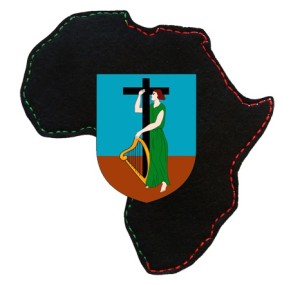
3.9 African Music Festival logo. The African Music Festival logo features a black map of Africa and Montserrat’s coat of arms, featuring Erin (the female personification of Ireland) holding an Irish harp and a black cross. Image source: http://www.montserratafricanmusicfest.com, accessed August 23, 2013.
Chapter 4:
Dancing to Listen: Navigating Rhythmic Soundscapes on Montserrat
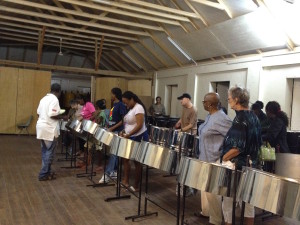
4.1 Volpanics Steel Pan Orchestra rehearsal. The Volpanics Steel Pan Orchestra, led by Herman “Cupid” Francis, rehearses at the Old Primary School in Salem. Tenor pans are on the far left, with seconds to their right, and guitars and cellos behind them. Bass drums are in the far back corner of the room. Photograph by Kathleen Spanos (January 13, 2014).
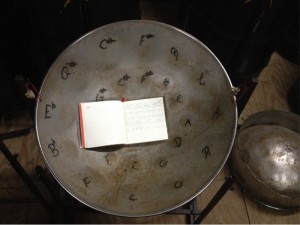
4.2 Tenor steel pan and notation. A tenor pan (marked with notes) and a notation book. Each note can be played in a high octave (outer circle) or low octave (inner circle). Photograph by Kathleen Spanos (July 15, 2014).
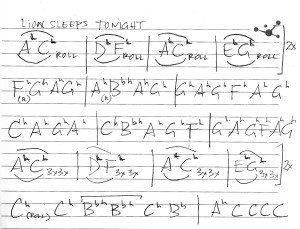
4.3 Tenor steel pan notation for “The Lion Sleeps Tonight”. This is my tenor pan notation for “The Lion Sleeps Tonight,” based on notation received from another Volpanics tenor player. I incorporated elements of notation that fellow band members taught me, as well as some that I created that have meaning just to me: the arcs indicate a 2-note chord (one note with each hand), the superscript “h” means “high octave” (played on the outer part of the pan), and the subscript “(r)” indicates a “roll” of the batons. This notation system primarily provides only the melody; rhythm and dynamics are learned mostly by ear and familiarity with the song.

4.4 Masquerade rhythm notations. These notations were transcribed from a CD-ROM of Montserrat’s masquerade music, provided to the author by ZJB Radio. These are the basic patterns identified in the goatskin snare drum part in the March, Rhythm #1 (Cudjoe Head #1), the Heel and Toe Polka, the Road March/Rumba, and Rhythm #5. The tempo markings are metronome approximations based on the CD-ROM recordings. Listen to the masquerade dance rhythms at: https://montserratrhythms.thekatespanos.com/masquerade-dance-music/. Transcriptions courtesy of Julia Topper (Musicology & Ethnomusicology Division, School of Music, College Park, MD).
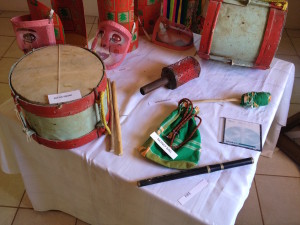
4.5 Masquerade exhibition at the National Trust. Traditional masquerade instruments and costume elements, including the fife (right) that plays the melody and goatskin snare/kettle drum (left) that responds with a “sweet” sound when played outside and warmed by the sun. This display was part of an exhibition of Montserratian culture at the National Trust in Woodlands. Photograph by Kathleen Spanos (March 27, 2014).
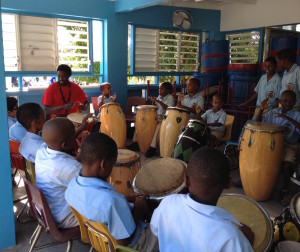
4.6 West African drumming lessons at St. Augustine. Dominique Mbaye of Senegal teaches the basic rhythms of West African djembe drumming to students at St. Augustine Primary School. Photograph by Kathleen Spanos (January 20, 2014).

4.7 Irish dancing lesson at Lookout Primary School. Kate Spanos teaches a “roll in” from an Irish social dance to students at Lookout Primary School. Photograph by Dominique Mbaye (February 22, 2014).
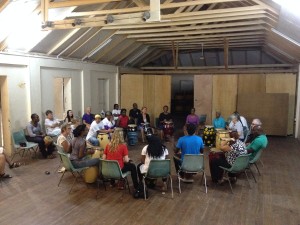
4.8 Blended Rhythms workshops for adults. The first adult Blended Rhythms workshops at the Old Salem Primary School: West African drumming with Dominique Mbaye (above). Photograph by Kathleen Spanos (January 14, 2014).
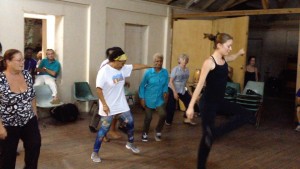
4.9 Blended Rhythms workshops for adults. The first adult Blended Rhythms workshops at the Old Salem Primary School: Irish dancing with Kate Spanos (below). Photograph by Kathleen Spanos (January 14, 2014).
4.10 Soca and assiko rhythm notation comparison. This notation comparison shows the fundamental similarities between the basic soca and assiko rhythm patterns. I learned the soca rhythm notation from online instructional videos, and I have transcribed the assiko rhythm from Blended Rhythms classes. Both in 4/4 time, the basic pattern includes a dotted 8th note beamed with a 16th note, followed by two beamed 8th notes, and repeated twice per measure. A variation is introduced in the second measure of the assiko notation. Both soca and assiko are subject to many variations, of course, but both are rooted in the same basic groove shown in the first measure.
Chapter 5:
Performing Reconfigurations of Community for Montserrat’s Future Archives
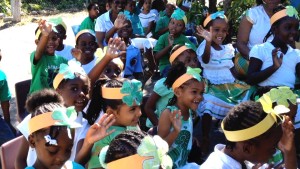
5.1 Montserratian students wave to Irish students. Students at St. Augustine Primary School smile and wave into the camera during a transatlantic Skype encounter with Gaelscoile d’ide Primary School in Fermoy, County Cork, Ireland. Photograph by Kathleen Spanos (March 12, 2014).
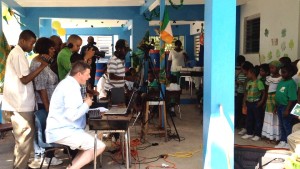
5.2 Transatlantic Skype call at St. Augustine School. The transatlantic Skype encounter took place in the St. Augustine Primary School assembly area, decorated with shamrocks, Irish flags, and the Montserrat national dress pattern for St. Patrick’s Day. Graham Clifford (center) took the helm behind his laptop and was surrounded by teachers, parents, and cameramen. The projection screen was on the far right, behind the students who were gathered to recite an Irish prayer. Photograph by Kathleen Spanos (March 12, 2014).
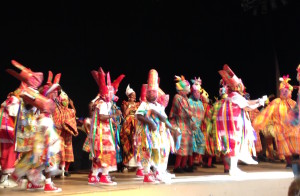
5.3 An exchange of masquerades from Montserrat and Guadeloupe. Masquerade performers from Montserrat and Guadeloupe dance on stage together during a cultural exchange event held at the Montserrat Cultural Centre at Little Bay. Photograph by Pablo Regis de Oliveira (March 21, 2015).
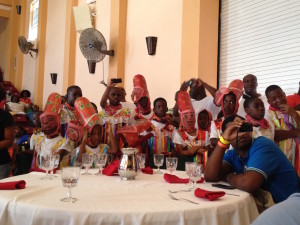
5.4 Montserratian masqueraders watch Guadeloupean masqueraders. Young Montserratian masquerade dancers gather around a table to watch Guadeloupean masqueraders with interest during a Montserrat/Guadeloupe cultural exchange held at the Cultural Centre in Little Bay, Montserrat. Photograph by Kathleen Spanos (March 21, 2015).
Videos and masquerade music are also available on this website:
